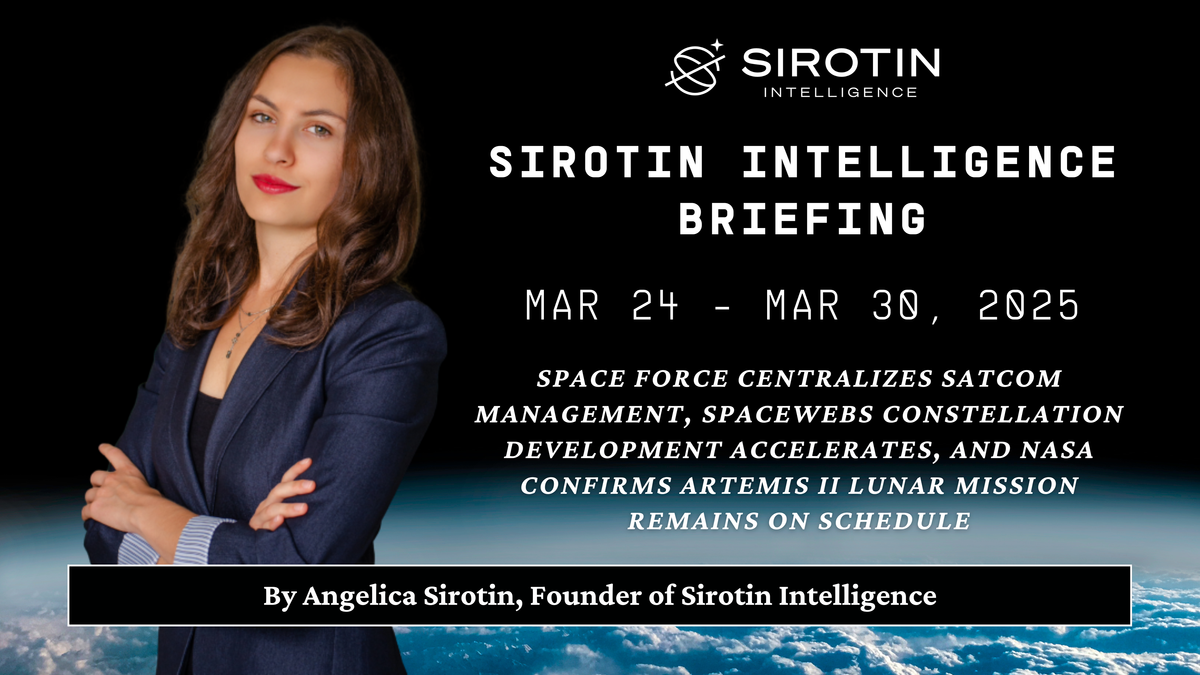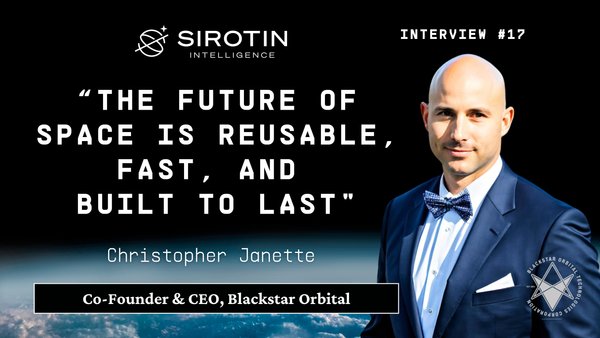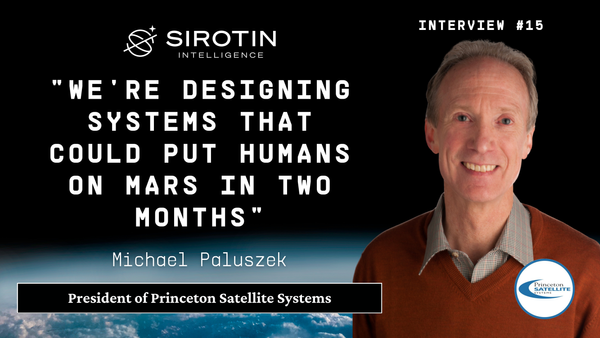Sirotin Intelligence Briefing: Mar 24 - Mar 30, 2025: Space Force Centralizes Satcom Management, Spacewebs Constellation Development Accelerates, And Nasa Confirms Artemis II Lunar Mission Remains On Schedule
Space Force Centralizes Satcom Management, Spacewebs Constellation Development Accelerates, And Nasa Confirms Artemis II Lunar Mission Remains On Schedule

This week's developments reveal a strategic pivot in space security as Space Force centralizes satellite communications management while SPACECOM leaders warn of narrowing capability gaps with adversaries. NASA's Artemis II remains on track for September 2025 despite mounting technical challenges, while new international partnerships between US-Argentina, Egypt-Jordan, and Taiwan-UK reshape space diplomacy. As Gravitics secures $60M to develop revolutionary orbital carrier capabilities, the race intensifies between America's entrepreneurial innovation and adversaries' centralized space ambitions.
🛡️ Defense Highlights
- Space Force Centralizes Commercial Satellite Communications Management: The U.S. Space Force is taking over commercial satellite communications contracts from the Defense Information Systems Agency, continuing the consolidation of space assets under Space Force management to streamline operations and enhance military space capabilities.
- SPACECOM Chief Highlights Escalating Threats to U.S. Space Infrastructure: U.S. Space Command is intensifying efforts to protect America's interests in space amid escalating threats from adversaries, with Commander Gen. Stephen Whiting emphasizing SPACECOM's crucial role in defending the homeland against potential attacks targeting critical space infrastructure.
- Space Force Developing Standardized Warfighting Doctrine Framework: The U.S. Space Force is developing a comprehensive warfighting framework that will standardize operational concepts and terminology, addressing a critical need for consistent doctrine as the service prepares for potential conflicts extending into the space domain.
- NASA's Parker Probe Survives Extreme Solar Flyby in Record-Breaking Mission: NASA's Parker Solar Probe has successfully completed its second extremely close flyby of the Sun, approaching within just 4.51 million miles of the solar surface while experiencing temperatures of around 2,500°F, gathering crucial data about our star's dynamics during a period of heightened solar activity.
- General Saltzman Pivots Space Force Budget Focus to Threat-Based Capabilities: Chief of Space Operations Gen. Chance Saltzman has outlined a fundamental transition in how the Space Force approaches its budget allocations, emphasizing a shift from focusing on system requirements to prioritizing operational capabilities that address specific threats from adversaries.
- Booz Allen Proposes 2,000-Satellite "Brilliant Swarms" for Enhanced Missile Defense: Booz Allen Hamilton has introduced a new satellite constellation concept called "Brilliant Swarms," designed to bolster missile defense capabilities through distributed, interconnected smallsats—up to 2,000 in total—that could detect and track missiles more effectively than traditional satellite architectures.
- Senator Questions Air Force's Potential Non-Competitive SpaceX Contract Shift: A U.S. senator has expressed apprehension about reports suggesting the Air Force might divert satellite contracts to SpaceX without proper competition, highlighting tensions between established defense procurement processes and the push for commercial innovation in military space capabilities.
🌐 Policy, Geopolitical & Legal Developments
- Commercial Space Expert Greg Autry Tapped for NASA CFO Position: President Trump has nominated Dr. Greg Autry, a prominent commercial space policy expert and professor, to serve as NASA's Chief Financial Officer, bringing extensive knowledge of space commercialization and public-private partnerships to help shape the agency's financial strategy during a pivotal period of expansion.
- NASA Science Director Identifies Launch Risk Tolerance as Critical Cost Factor: NASA Science Mission Directorate head Bobby Braun has highlighted risk tolerance in launch services as a critical factor affecting mission costs, suggesting that greater acceptance of calculated risks could lead to significant cost reductions while maintaining science returns on future space exploration projects.
- NASA Reveals Astronaut Lineup for SpaceX Crew-11 ISS Mission: NASA has officially revealed the astronaut roster for the upcoming SpaceX Crew-11 mission to the International Space Station, continuing the agency's Commercial Crew Program that has maintained an uninterrupted American presence on the orbiting laboratory since 2020.
- Research Shows Space Station Living Compromises Astronaut Immune Function: Studies conducted on the International Space Station have found that extended stays in microgravity significantly impair astronauts' immune functions, potentially increasing vulnerability to infections during long-duration missions, with implications for future deep space exploration and Mars journeys.
- Egypt and Jordan Sign New Space Technology Collaboration Agreement: Egypt and Jordan have signed a new agreement to enhance collaboration on space technology initiatives, focusing on joint satellite development, Earth observation capabilities, and technical training programs that will strengthen both nations' positions in the growing Middle Eastern space sector.
- Taiwan and UK Launch Strategic Space Technology Partnership: Taiwan's TACC and ITRI have established a significant partnership with UK space technology companies, focusing on advanced GPS systems, satellite communications, and other space applications with dual commercial and security applications, representing an important step in Taiwan's international space cooperation initiatives.
- Artemis II On Schedule While Artemis III Awaits Critical SpaceX Milestones: NASA officials have confirmed that the Artemis II crewed mission around the Moon remains on schedule for September 2025, while noting that Artemis III's planned lunar landing faces uncertainty as NASA awaits essential development milestones from SpaceX's Starship Human Landing System before committing to a firm launch date.
- U.S. and Argentina Strengthen Bilateral Space Cooperation Framework: The U.S. and Argentina have concluded productive bilateral space consultations, agreeing to enhance collaboration on satellite technology, Earth observation, planetary exploration, and strengthen regulatory frameworks for commercial space activities, reinforcing their commitment to peaceful space utilization and scientific advancement.
🛰️ Technology & Commercial Developments
- NASA Advances Precision Landing Technology for Future Planetary Missions: NASA has successfully tested new precision landing technologies designed to enable spacecraft to touch down with unprecedented accuracy on the Moon, Mars, and other celestial bodies, advancing capabilities crucial for resource utilization, habitat construction, and exploration of challenging terrain.
- Satellite-Mapped Ocean Currents Could Transform Marine Waste Cleanup: Researchers are leveraging advanced space technology to map ocean currents with unprecedented precision, potentially transforming marine waste cleanup efforts by predicting debris movements and optimizing collection strategies for plastic and other pollutants.
- Space-Based Agricultural Technologies Promise Global Crop Yield Increases: New applications of satellite technology and data analytics are demonstrating impressive potential to increase agricultural productivity, with precision farming techniques informed by space-based observations helping farmers optimize water usage, reduce pesticide applications, and improve harvest timing.
- Webb Telescope Captures Unprecedented Images of Neptune's Auroras: The James Webb Space Telescope has detected striking auroral emissions in Neptune's polar regions, revealing new details about the ice giant's atmospheric composition and electromagnetic processes, and demonstrating Webb's capabilities for studying planetary atmospheres beyond our solar neighborhood.
- Miles Space Successfully Tests Revolutionary Water-Powered Propulsion System: Miles Space has conducted a successful flight demonstration of its innovative water-fueled propulsion system, potentially offering a safer, more sustainable alternative to traditional chemical thrusters for satellite maneuvering and attitude control in orbit.
- China Expands Tianlian Satellite Network to Support Human Spaceflight: China has successfully launched a new Tianlian data relay satellite, expanding its space-based communications network that provides critical support for the country's human spaceflight missions, including operations on its Tiangong space station and future lunar exploration efforts.
- China Unveils Multi-Decade Planetary Exploration Plan Focusing on Habitability: China has revealed a comprehensive roadmap for planetary exploration focusing on investigating habitability across the solar system and searching for evidence of extraterrestrial life, outlining missions to Mars, Venus, Jupiter, and the outer solar system over the next two decades.
- "Space Shrooms" Mission Successfully Demonstrates Mushroom Growth Potential in Orbit: The Mission MushVrooms payload has demonstrated successful mushroom cultivation in space, paving the way for sustainable food production capabilities in orbit. The experiment, which included strains of various edible and medicinal mushrooms, provides valuable insights for developing regenerative food systems that could support long-duration space missions without relying on resupply from Earth.
- Scientists Develop New Theory Explaining Benzene Formation in Interstellar Space: Scientists have formulated a new theory that explains how benzene molecules can form in the harsh conditions of interstellar space, solving a long-standing mystery about the presence of this complex organic compound outside our solar system. The research has significant implications for understanding the chemical evolution of the universe and potentially the origins of life, as benzene is a fundamental building block for more complex organic molecules.
💭 A Word From Christophe Bosquillon
Intelligence Contributor, Senior Editor at Sirotin Intelligence
Right after last week's discussion we heard General Chance Saltzman's worrying about budgetary restrictions and requesting a ‘fundamental shift’ in Space Force budgets. General Stephen N. Whiting, Commander, United States Space Command, testified at the hearings of the US Senate Armed Services Committee’s Subcommittee on Strategic Forces. In his presentation on Priorities and Posture of U.S. Space Command for Fiscal Year 2026, General Whiting asserted that "US SPACECOM will remain prepared to address the evolving threat landscape, deter aggression, counter adversary actions, and safeguard America’s interests in space today and for generations to come."
The week concluded with Dr. Troy Meink, nominee to be Secretary of the Air Force, endorsing ‘Space Control’ and counter-space weapons, but warning that the U.S. must urgently accelerate its space capabilities to counter rapidly advancing threats. To regain the upper hand and win space-based conflicts requires suppressing the current disconnect between space defense rhetoric and reality: the service needs space weapons, logistics, and training, meant for Guardians to fight, dominate, and win.
The U.S. government increasingly relies on the private sector for key space defense capabilities: Gravitics has just been selected by the Space Force for a $60M STRATFI to demonstrate its revolutionary Orbital Carrier. This game-changer will shield and pre-position multiple maneuverable space vehicles that can deliver a rapid response to address threats on orbit.
Changing inclinations on orbit (ascending and descending) comes with a huge energy and DeltaV bill. But bypassing traditional launch constraints enables space vehicle operators to rapidly select a deployment orbit on-demand. Such carrier could host space-to-surface weapons, or other space-based weapons to be housed on orbit until needed, then deployed for an immediate deterrent or warfighting effect. A move in the right direction as America must stop falling behind in space defense and other critical technologies such as hypersonics.
Civil society must rekindle education in science and technology to supercharge space defense. It may not be possible to outspend an adversarial command economy hell-bent on hegemony. But banking on their infinite resourcefulness, the American People will be able to out-entrepreneur such adversaries.
To empower Guardians, at the heart of America’s warrior ethos, to deter, fight, and win wars in space.
Have a great space week ahead!
🎤 Our Next Guest
Wednesday, April 3rd, we're thrilled to present our exclusive interview with Christopher Janette, President and CEO of BlackStar Orbital, a visionary entrepreneur transforming satellite technology through revolutionary reusable "hypersonic satellites" designed to operate in space and return safely to conventional runways.
🔍 Topics Covered:
- His journey from Air Force maintainer pushing jet engines to 110% capacity to pioneering space entrepreneur
- BlackStar Orbital's game-changing approach to satellite design—combining orbital capabilities with aircraft-like reusability
- How America's hypersonic capabilities compare to China's rapid advances in fractional orbital bombardment systems
- The reality of space as a contested military domain where satellites already engage in non-kinetic warfare
- Why the future of space infrastructure must be reusable, fast, and built to last
- BlackStar's development of spacecraft that can land on any of the 14,000 runways worldwide over 5,000 feet long
Don't miss this deep dive with a hands-on innovator tackling one of space security's most critical challenges. While traditional satellites become increasingly vulnerable to adversarial threats, Janette represents the entrepreneurial spirit driving America's response—creating resilient, adaptable systems that can maneuver, return, and evolve with emerging threats in the new orbital battlefield.
📚 Essential Intel from Our Archives
Missed a beat? These groundbreaking conversations are must-reads:
"We're Treating Satellites Like They're Still In The 1990s"
Niha Agarwalla, Director of Commercial Space, explains why traditional satellites are obsolete and how resilient constellations will transform space economics.
"When People See Space Guardians in Uniform, They Ask If They're Real"
Colonel Bill Woolf, 25-year space defense veteran, reveals his mission to build public support for the newest military branch defending America's orbital assets.
"One Kilogram of Helium-3 Is Worth $50 Million"
Jeffrey Max, Magna Petra CEO, explains how lunar resource extraction could revolutionize Earth's energy production and fuel humanity's expansion across the solar system.
"I'm Building a Rocket Engine That Could Reach Alpha Centauri"
Michael Paluszek, Princeton Satellite Systems President, reveals how fusion propulsion could reduce travel times throughout our solar system and enable humanity's first interstellar missions.
"Space Has a Scottish Accent"
Chris Newlands, CEO of Space Aye, discusses how his company's satellite technology is revolutionizing wildlife conservation and helping to combat illegal fishing and poaching.
"I Learned From the Last Generation of Manhattan Project Veterans”
Patrick McClure, former Kilopower Project Lead at Los Alamos National Laboratory, explains how small nuclear reactors could power future missions to the Moon, Mars, and beyond.
"We're Being Attacked Every Day"
Christopher Stone, Former Pentagon Space Advisor, warns about America's vulnerabilities in orbit and explains why China's "attack to deter" doctrine makes space conflict more likely than many realize.
"I Helped SpaceX Secure Their First Commercial Contracts"
Serial entrepreneur Robert Feierbach discusses building billion-dollar space ventures across four continents and developing North America's newest spaceport.
"We Can Fly 8,000 Miles In 2 Hours"
Jess Sponable, Ex-DARPA PM & President of NFA, explains how rocket-powered aircraft will revolutionize global travel through simplified hypersonic technology.
"This Could Be Our Biggest Economy"
Kevin O'Connell, Former Space Commerce Director, reveals how space is transforming from a government domain to a $1.8 trillion market.
"How Do You Win a War in Space?"
Ram Riojas, Ex-Nuclear Commander and Space Defense Expert, explains why the next war will start in space and how nations are preparing their defenses.
"First Day on the Job, Hubble Was Broken"
Mike Kaplan, James Webb Space Telescope Pioneer, reveals how early setbacks with Hubble shaped NASA's approach to complex space missions.
The Future of Human Space Habitation
Jules Ross reveals how her journey from artist to space visionary is reshaping human adaptation to space through Earth's first artificial gravity station.
Space Law's New Frontier
Attorney Michael J. Listner unpacks the complex legal challenges facing modern space activities. From resource rights to orbital debris management
Making Oceans Transparent From Space
Navy Legend Guy Thomas, inventor of S-AIS, shares how his invention transformed global maritime surveillance and security.





